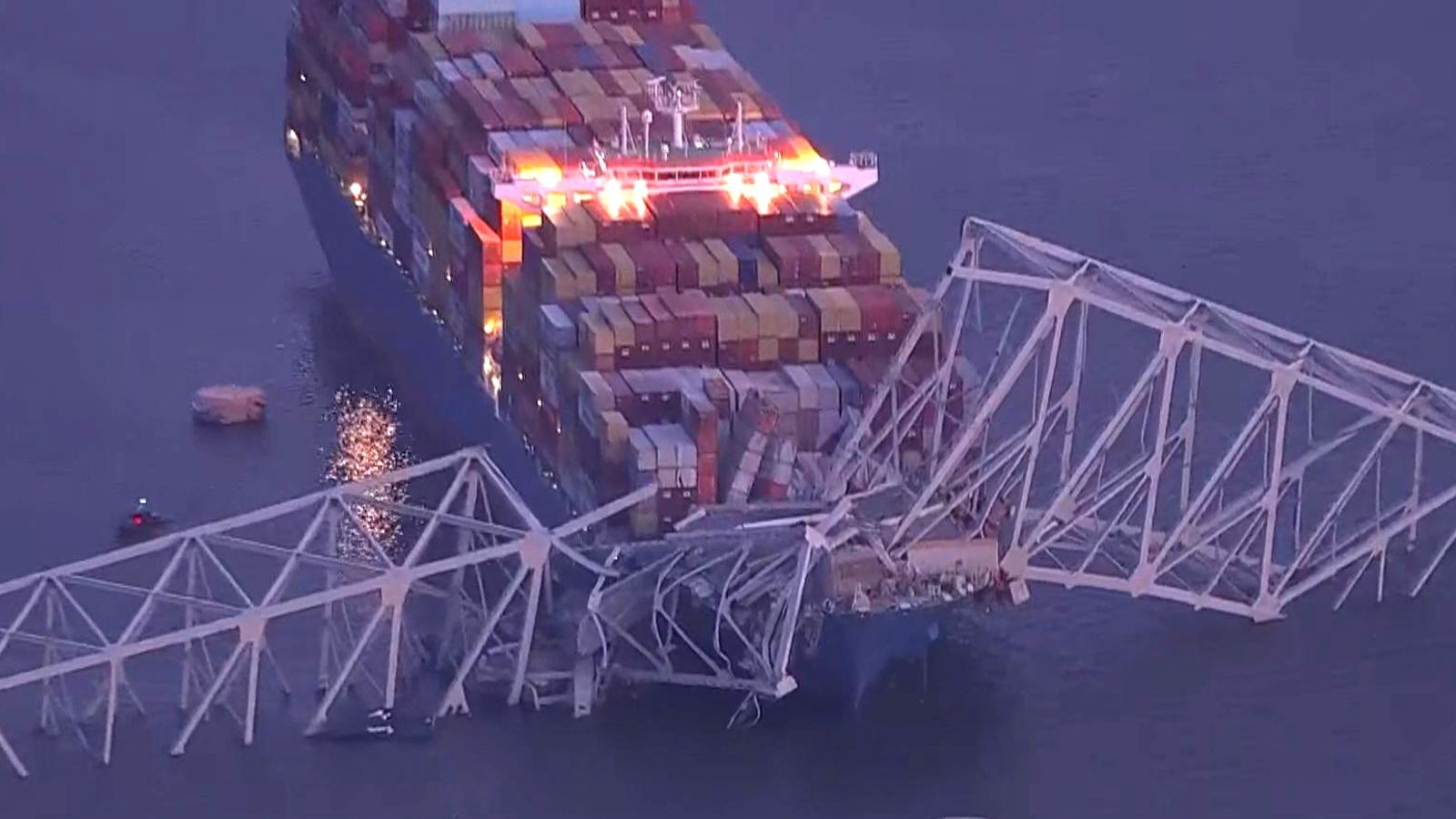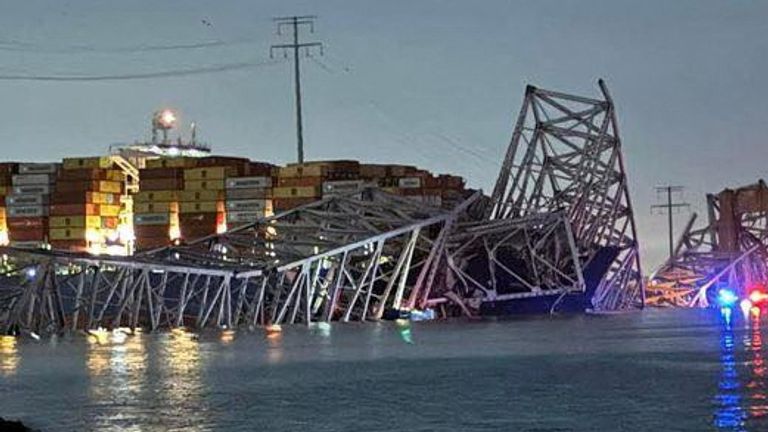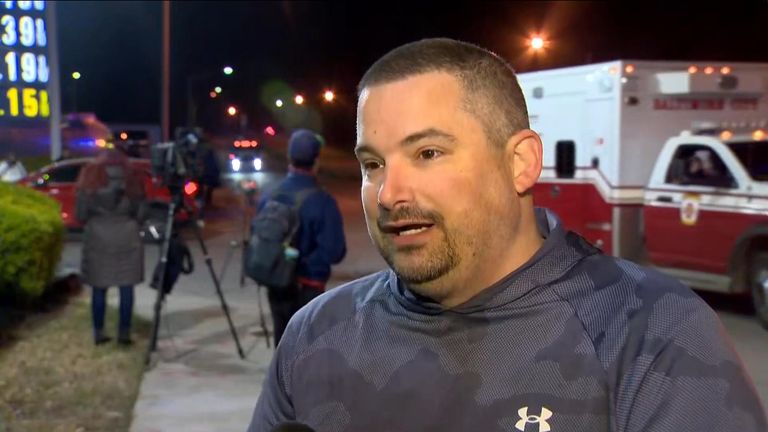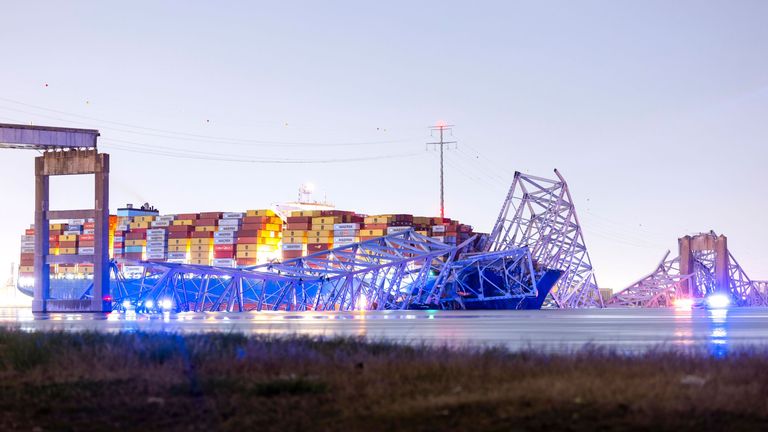In an instant, a large section of the Francis Scott Key Bridge was gone – as dozens of its steel beams collapsed into the water after being hit by a cargo ship.
But how could such a catastrophe have happened?
Baltimore bridge latest:
Follow live updates
What do we know about bridge and the ship that hit it?
Emergency services are still at the scene and details about casualties are still emerging.
Sky News has spoken to a number of maritime and engineering experts to try and understand what might have happened – and what issues may have been at play.
Was human error to blame?
Professor Helen Sampson, an expert at the Seafarers International Research Centre at Cardiff University, says the crash may have been caused by someone’s mistake.
She told Sky News: “Was there some sort of miscommunication or misunderstanding between the pilot and the crew? Or was there a pilot error?”
The time of day when the disaster occurred – around 1.30am local time – gives rise to concerns about tiredness, she added.
“The time makes me also wonder whether there was an element of fatigue at play…
“It’s almost always the case that we focus on human error at the individual level, it’s almost always the case that there’s a broader context which has resulted in that human error, like fatigue and the demands made on pilots or on crews.”
What about a mechanical problem?
However, another maritime safety expert says the “most likely” cause of the crash was a failure in the ship’s machinery.
David McFarlane, director of Maritime Risk and Safety Consultants Ltd, told Sky News: “The first thing that springs to my mind is: was there a sudden fault with the ship’s engines or the steering gear?”
Mr McFarlane said a human error was less likely because of the number of people who would have been on duty.
“There should be no room for one-person errors because one of the other people should jump in and say ‘hang on’,” he said.
“The most likely cause of this is a failure in machinery or steering gear, but we just won’t know until the authorities have been on board. And even then, they’re unlikely to say what’s been going on for some considerable time.”
Prof Sampson said a mechanical failure with the steering gear or something similar would be the “most dramatic” explanation for what happened.
Officials have confirmed the ship that crashed into the bridge had issued a mayday call and had lost power.
Was there a design flaw in the bridge?
Opened in 1977, the Francis Scott Key Bridge is named after the poet who wrote the words to the Star Spangled Banner, the American national anthem.
Constructed from steel, it was 1.6 miles long and not dissimilar to some bridges in the UK, one expert told Sky News.
Julian Carter, a structural and civil engineering expert, said these structures are simple in concept – but “very weak” at certain points.
“It’s what we call a continuous structure every little piece is connected to another – and unfortunately it’s a catastrophic collapse.”
Read more: What do we know so far about bridge collapse?
Professor Barbara Rossi, an expert in engineering science at the University of Oxford, said the impacting force of the cargo ship must have been “immense” to lead to the collapse of the concrete structures underpinning the bridge.
“We should not speculate around if such huge impact forces should have been taken into account at the design stage,” she added.
There has also been discussion about whether “dolphins” (steel structures embedded in the seabed to stop or divert a ship) or artificial islands may have been inadequate.
Bridge designer Robert Benaim said: “I do not know what the arrangements were for this bridge but major bridges over shipping lanes must have substantial protection for piers or columns.”
He added: “If piers are not protected adequately then they are vulnerable to ship collision. Clearly the protection of the piers in this instance was inadequate. A pier or column of a bridge could never resist the impact of a large ship. They must be protected from collision.”





